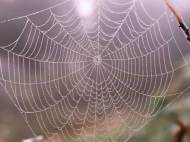Secrets of spider web design
 While many research groups investigate toughness of spider silk by investigating the material itself, researchers from Massachusetts Institute of Technology (MIT) and the Politecnico di Torino in Italy combined experimental observations of spider webs with complex computer simulations to discover that web durability relies on the overall web design which compensates for potential stress of the web.
While many research groups investigate toughness of spider silk by investigating the material itself, researchers from Massachusetts Institute of Technology (MIT) and the Politecnico di Torino in Italy combined experimental observations of spider webs with complex computer simulations to discover that web durability relies on the overall web design which compensates for potential stress of the web.
“While the strength and toughness of silk has been touted before–it is stronger than steel and tougher than Kevlar by weight – the advantages of silk within a web, beyond such measures, has been unknown”, said Markus Buehler, associate professor of civil and environmental engineering at MIT. “But, while we understand the peculiar behavior of dragline silk from the ‘nanoscale up’ – initially stiff, then softening, then stiffening again–we have little insight into how the molecular structure of silk uniquely improves the performance of a web.”
Although webs seem as if they were made out of a same material, one web contains multiple silk types. For example, viscid silk is stretchy, wet and sticky, and it is the silk that winds out in increasing spirals from the web center, while dragline silk is stiff and dry, and it serves as the threads that radiate out from a web’s center, providing structural support. Dragline silk is crucial to the mechanical behavior of the web.
/
Through a series of computer models matched to laboratory experiments with spider webs with similar spiraling web patterns crafted by orb weavers (Nephila clavipes), garden spiders (Araneus diadematus) and others, the researchers were able to analyze roles of different web elements.
“For our models, we used a molecular dynamics framework in which we scaled up the molecular behavior of silk threads to the macroscopic world. This allowed us to investigate different load cases on the web, but more importantly, it also allowed us to trace and visualize how the web fractured under extreme loading conditions”, said Anna Tarakanova, who developed the computer models along with Steven Cranford, both graduate students in Buehler’s Laboratory for Atomistic and Molecular Mechanics.
After making computer model of the web components, the researchers were able to create ‘synthetic’ webs, constructed out of virtual silks that mimicked natural materials with properties from typical engineering materials such as those that are linear elastic, like many ceramics, and elastic-plastic materials. After creating different webs, the researchers compared performance of modeled web and natural silk in order to find the best match.
That enabled them to analyze the web in terms of energy, and details of the local stress and strain. The results showed that the radial and spiral filaments each play different roles in attenuating motion, and when stresses are particularly harsh, they are sacrificed so that the entire web may survive.
According to the researchers’ findings, the failure of silk threads occurs at points where the filament is disturbed by that external force, but after failure, the web returns to stability – even in simulations using forces equivalent to hurricane-force winds.
“Engineered structures are typically designed to withstand large loads with limited damage, but extreme loads are more difficult to account for”, said Cranford. “The spider has uniquely solved this problem by allowing a sacrificial member to fail under high load. One of the first questions a structural engineer must ask is ‘What is the design load?’ For a spider web, however, it doesn’t matter if the load is just strong enough to cause failure, or one hundred times higher–the net effect is the same. Allowing a sacrificial member to fail removes the unpredictability of ‘extreme’ loads from the design equation.”
For more information, read the article published in the journal Nature: “Nonlinear material behaviour of spider silk yields robust webs”.









There is great symmetry in Spider’s Web. Hence the same has been adopted in Computers as WEB.
Dr.A.Jagadeesh Nellore(AP),India
E-mail: anumakonda.jagadeesh@gmail.com